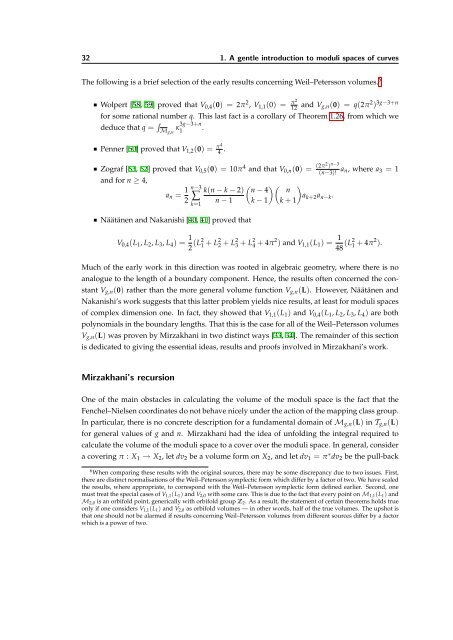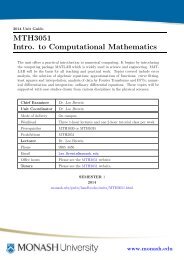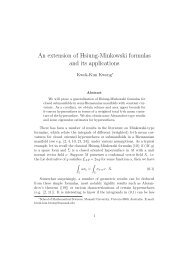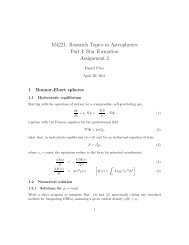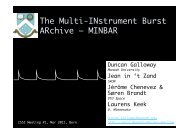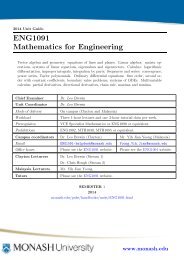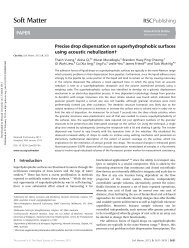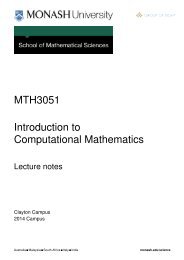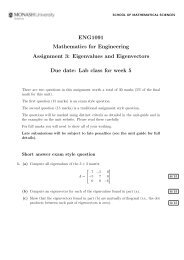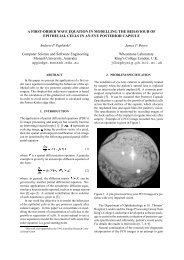Intersection theory on moduli spaces of curves ... - User Web Pages
Intersection theory on moduli spaces of curves ... - User Web Pages
Intersection theory on moduli spaces of curves ... - User Web Pages
You also want an ePaper? Increase the reach of your titles
YUMPU automatically turns print PDFs into web optimized ePapers that Google loves.
32 1. A gentle introducti<strong>on</strong> to <strong>moduli</strong> <strong>spaces</strong> <strong>of</strong> <strong>curves</strong>The following is a brief selecti<strong>on</strong> <strong>of</strong> the early results c<strong>on</strong>cerning Weil–Peterss<strong>on</strong> volumes. 6Wolpert [58, 59] proved that V 0,4 (0) = 2π 2 , V 1,1 (0) = π212 and V g,n(0) = q(2π 2 ) 3g−3+nfor some rati<strong>on</strong>al number q. This last fact is a corollary <strong>of</strong> Theorem 1.26, from which wededuce that q = ∫ M g,nκ 3g−3+n1.Penner [50] proved that V 1,2 (0) = π44 .Zograf [63, 62] proved that V 0,5 (0) = 10π 4 and that V 0,n (0) = (2π2 ) n−3a n , where a 3 = 1and for n ≥ 4,a n = 1 2n−3∑k=1k(n − k − 2)n − 1Näätänen and Nakanishi [40, 41] proved that(n−3)!( )( )n − 4 nak − 1 k + 1 k+2 a n−k .V 0,4 (L 1 , L 2 , L 3 , L 4 ) = 1 2 (L2 1 + L2 2 + L2 3 + L2 4 + 4π2 ) and V 1,1 (L 1 ) = 148 (L2 1 + 4π2 ).Much <strong>of</strong> the early work in this directi<strong>on</strong> was rooted in algebraic geometry, where there is noanalogue to the length <strong>of</strong> a boundary comp<strong>on</strong>ent. Hence, the results <strong>of</strong>ten c<strong>on</strong>cerned the c<strong>on</strong>stantV g,n (0) rather than the more general volume functi<strong>on</strong> V g,n (L). However, Näätänen andNakanishi’s work suggests that this latter problem yields nice results, at least for <strong>moduli</strong> <strong>spaces</strong><strong>of</strong> complex dimensi<strong>on</strong> <strong>on</strong>e. In fact, they showed that V 1,1 (L 1 ) and V 0,4 (L 1 , L 2 , L 3 , L 4 ) are bothpolynomials in the boundary lengths. That this is the case for all <strong>of</strong> the Weil–Peterss<strong>on</strong> volumesV g,n (L) was proven by Mirzakhani in two distinct ways [33, 34]. The remainder <strong>of</strong> this secti<strong>on</strong>is dedicated to giving the essential ideas, results and pro<strong>of</strong>s involved in Mirzakhani’s work.Mirzakhani’s recursi<strong>on</strong>One <strong>of</strong> the main obstacles in calculating the volume <strong>of</strong> the <strong>moduli</strong> space is the fact that theFenchel–Nielsen coordinates do not behave nicely under the acti<strong>on</strong> <strong>of</strong> the mapping class group.In particular, there is no c<strong>on</strong>crete descripti<strong>on</strong> for a fundamental domain <strong>of</strong> M g,n (L) in T g,n (L)for general values <strong>of</strong> g and n. Mirzakhani had the idea <strong>of</strong> unfolding the integral required tocalculate the volume <strong>of</strong> the <strong>moduli</strong> space to a cover over the <strong>moduli</strong> space. In general, c<strong>on</strong>sidera covering π : X 1 → X 2 , let dv 2 be a volume form <strong>on</strong> X 2 , and let dv 1 = π ∗ dv 2 be the pull-back6 When comparing these results with the original sources, there may be some discrepancy due to two issues. First,there are distinct normalisati<strong>on</strong>s <strong>of</strong> the Weil–Peterss<strong>on</strong> symplectic form which differ by a factor <strong>of</strong> two. We have scaledthe results, where appropriate, to corresp<strong>on</strong>d with the Weil–Peterss<strong>on</strong> symplectic form defined earlier. Sec<strong>on</strong>d, <strong>on</strong>emust treat the special cases <strong>of</strong> V 1,1 (L 1 ) and V 2,0 with some care. This is due to the fact that every point <strong>on</strong> M 1,1 (L 1 ) andM 2,0 is an orbifold point, generically with orbifold group Z 2 . As a result, the statement <strong>of</strong> certain theorems holds true<strong>on</strong>ly if <strong>on</strong>e c<strong>on</strong>siders V 1,1 (L 1 ) and V 2,0 as orbifold volumes — in other words, half <strong>of</strong> the true volumes. The upshot isthat <strong>on</strong>e should not be alarmed if results c<strong>on</strong>cerning Weil–Peterss<strong>on</strong> volumes from different sources differ by a factorwhich is a power <strong>of</strong> two.


